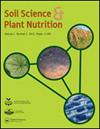施钾降低了大豆植株对铯的吸收并改变了锶的转运
IF 1.8
4区 农林科学
Q3 ENVIRONMENTAL SCIENCES
引用次数: 1
摘要
2011年东京电力公司福岛第一核电站事故发生后,放射性铯(RCs)在周围环境中的释放浓度高于放射性锶(RSr)。大多数对策都是为了减轻土壤中RCs向植物的转移。然而,为了避免切尔诺贝利和马亚克核事故后发生的事情,防止放射性物质从土壤转移到植物中应该是一个优先事项。虽然施用钾(K)肥料是防止受污染农田中农作物吸收rc的最有效方法,但这种实施增加了成本和劳动力需求。考虑到核事故的准备工作,如果rc和RSr同时释放,这种对策将如何受到影响尚不清楚。本研究旨在探讨施钾对大豆植株和土壤中铯(Cs)和锶(Sr)吸收的影响及其与其他元素的相互作用和相关性。田间试验在日本福岛县进行,采用不同施钾量(即不施钾、正常施钾和高施钾)。测定了植物中K、Cs、Sr、钙(Ca)、镁(Mg)和氮(N)的干重和矿物浓度,以及土壤中交换性K (ExK)、交换性Cs (ExCs)、交换性Sr (ExSr)、交换性Ca (ExCa)、交换性Mg (ExMg)、NH4+(铵)和NO3-(硝酸盐)的浓度。本研究表明,施钾降低了土壤中Cs、Ca和Mg的吸收,但不影响ExSr、ExCa和ExMg的浓度,也不改变Sr的吸收。另一方面,植株的K浓度尤其是生长后期的K浓度,表明K浓度对Sr的再转运有负调控作用。本文章由计算机程序翻译,如有差异,请以英文原文为准。
Potassium applications reduced cesium uptake and altered strontium translocation in soybean plants
ABSTRACT After the Tokyo Electric Power Company’s Fukushima Dai-ichi Nuclear Power Plant accident in 2011, radioactive cesium (RCs) was released in greater concentrations than radioactive strontium (RSr) in the surrounding environment. Most of the countermeasures were developed to mitigate the RCs transfer from the soil to plants. However, to avoid what has happened after the Chernobyl and Mayak accidents, preventing the transfer of RSr from soil to plants should be a priority. Although the application of potassium (K) fertilizers is the most effective method for preventing agricultural crops from absorbing RCs in contaminated fields, this implementation increases the cost and labor requirements. Considering the preparedness for nuclear accidents, it remains unclear how this countermeasure will be affected if RCs and RSr are released simultaneously. We aimed to explore the effect of K applications on cesium (Cs) and strontium (Sr) uptake and their interaction with and correlation to other elements in the soybean plants and soil. The field experiments were conducted in Fukushima Prefecture, Japan, using different K applications (i.e., no, normal, and high K applications). The dry weight and mineral concentrations of K, Cs, Sr, calcium (Ca), magnesium (Mg), and nitrogen (N) concentration in plants and exchangeable K (ExK), exchangeable Cs (ExCs), exchangeable Sr (ExSr), exchangeable Ca (ExCa), exchangeable Mg (ExMg), NH4+ (ammonium), and NO3- (nitrate) concentrations in the soils were evaluated. This study revealed that K application reduced Cs, Ca, and Mg uptake but did not affect the ExSr, ExCa, and ExMg concentrations in the soil and did not change the uptake of Sr. On the other hand, K concentration of the plant especially at later growth stage, which indicates re-translocation of Sr was negatively regulated by K concentration.
求助全文
通过发布文献求助,成功后即可免费获取论文全文。
去求助
来源期刊

Soil Science and Plant Nutrition
农林科学-农艺学
CiteScore
4.80
自引率
15.00%
发文量
56
审稿时长
18-36 weeks
期刊介绍:
Soil Science and Plant Nutrition is the official English journal of the Japanese Society of Soil Science and Plant Nutrition (JSSSPN), and publishes original research and reviews in soil physics, chemistry and mineralogy; soil biology; plant nutrition; soil genesis, classification and survey; soil fertility; fertilizers and soil amendments; environment; socio cultural soil science. The Journal publishes full length papers, short papers, and reviews.
 求助内容:
求助内容: 应助结果提醒方式:
应助结果提醒方式:


